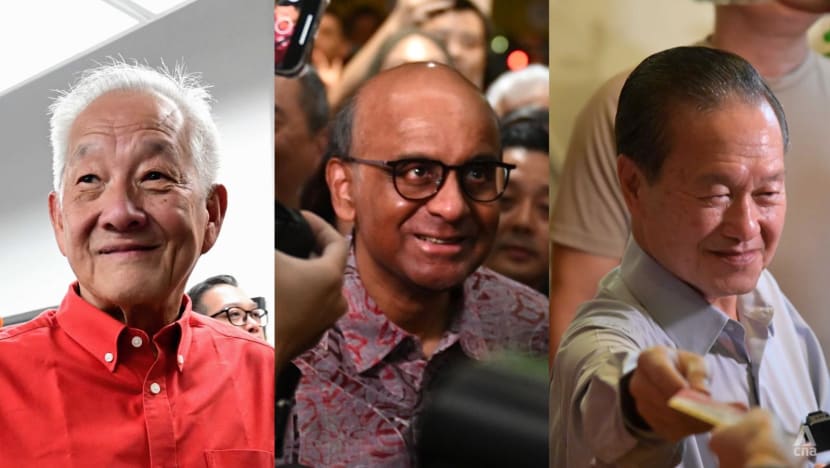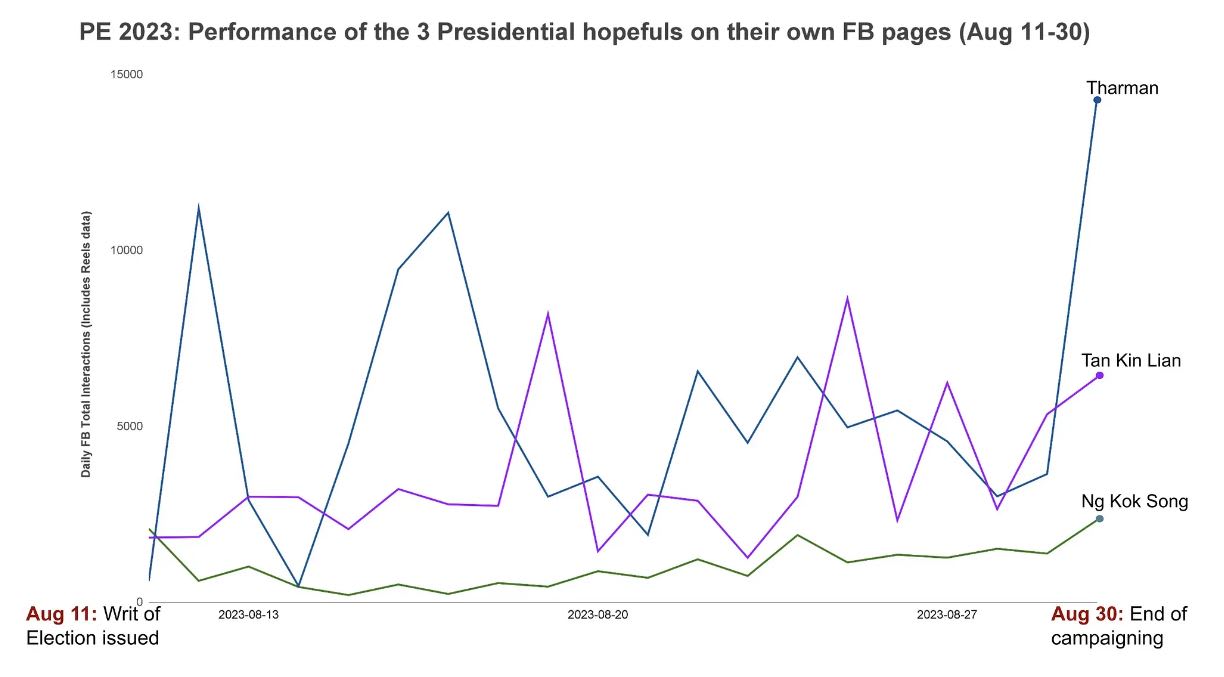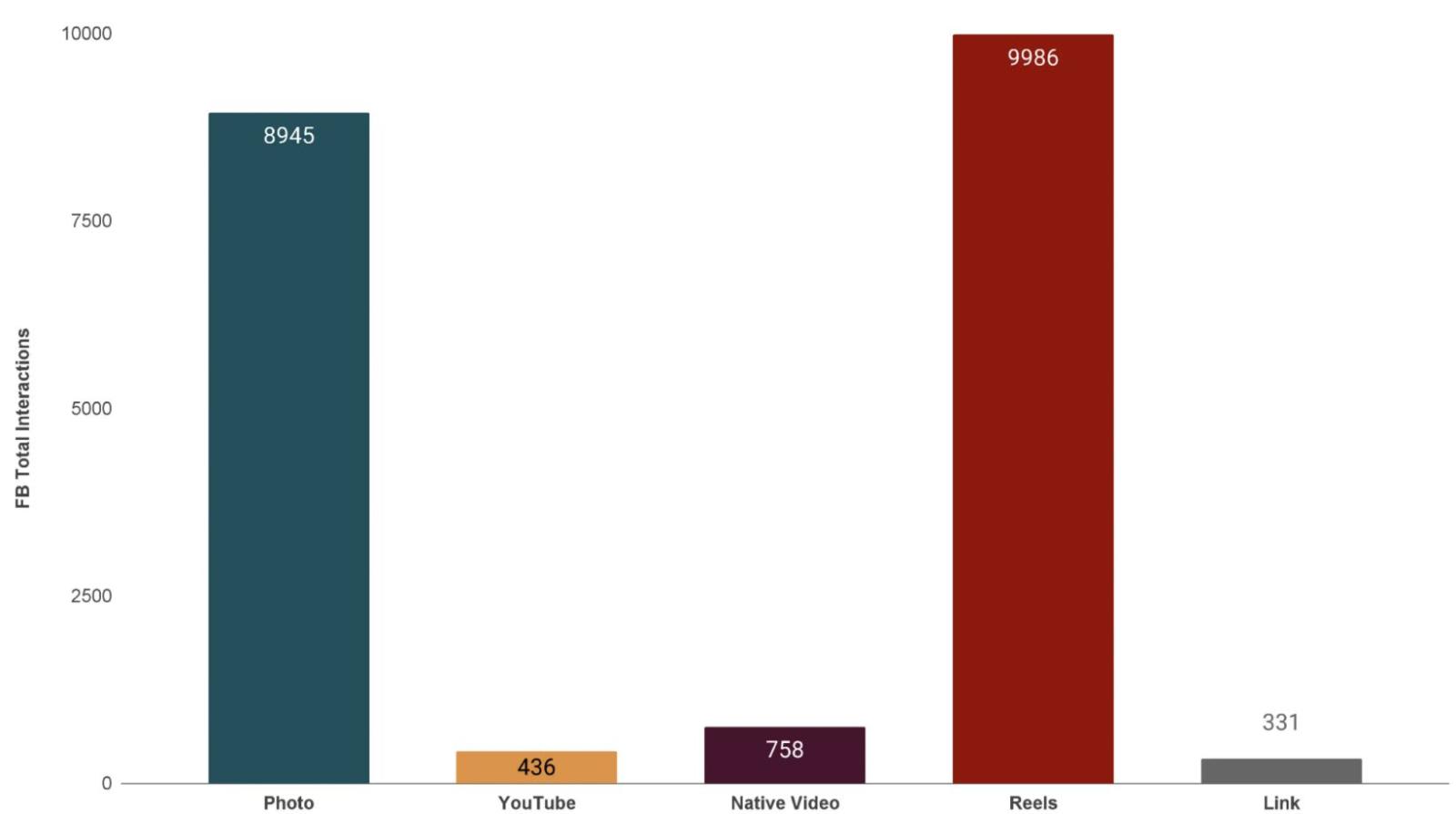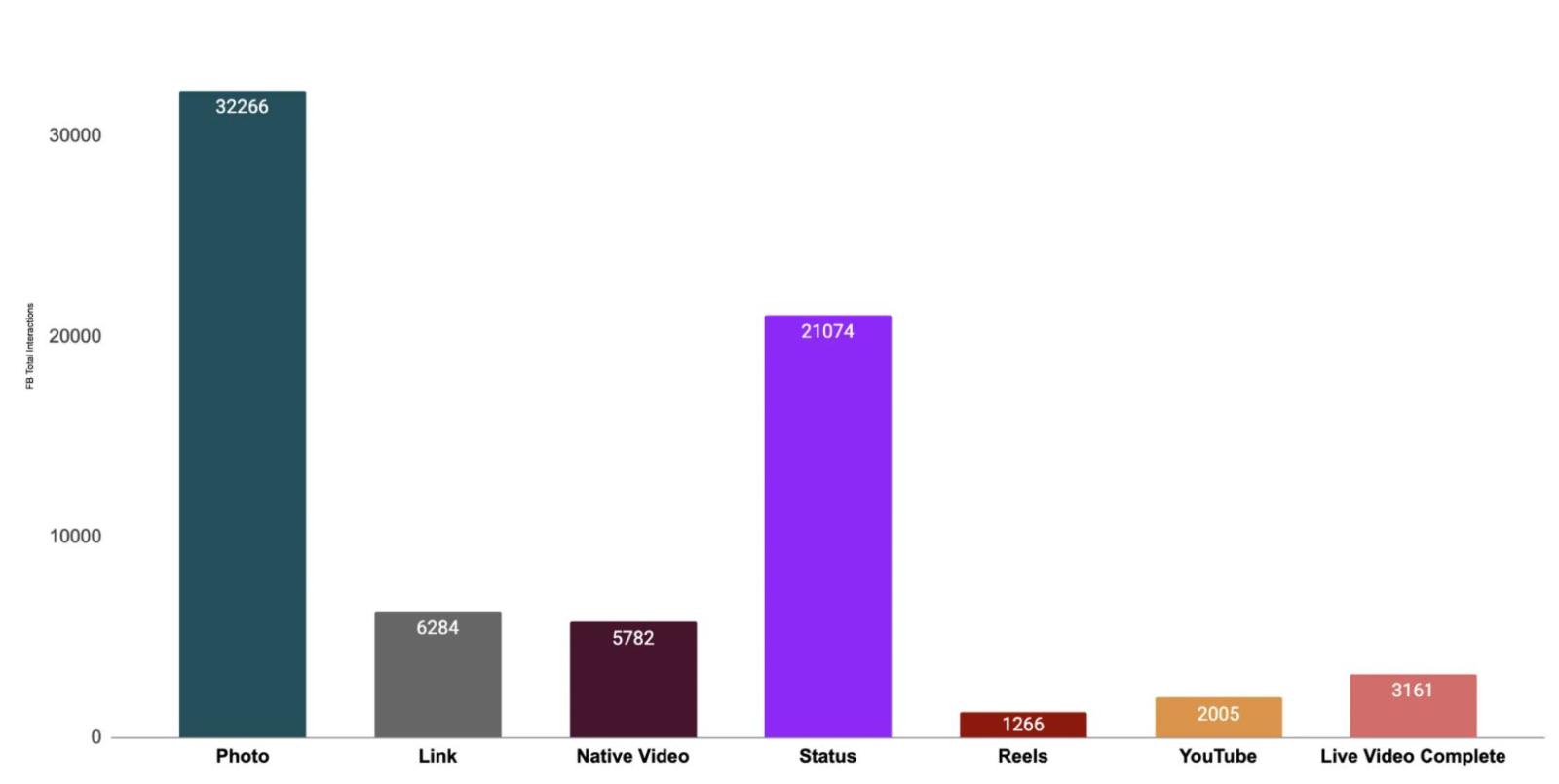Commentary: Presidential Election shows the long reach of short-form videos in Singapore politics
The immense popularity of short-form videos - particularly in President-elect Tharman Shanmugaratnam’s winning campaign - suggests that other political candidates will have to master this particular format for future elections, says Chua Chin Hon, Lead, Artificial Intelligence Strategy and Solutions for Mediacorp News Group.

Mr Ng Kok Song, Mr Tharman Shanmugaratnam and Mr Tan Kin Lian react to the sample count results of the Presidential Election on Sep 1, 2023. (Photos: CNA/Try Sutrisno Foo, Jeremy Long, Raydza Rahman)
SINGAPORE: Despite the rise of TikTok in recent years, the quest for eyeballs and online attention in Singapore’s recently concluded Presidential Election was still fought primarily on Facebook, the largest legacy social media platform.
But the immense popularity of short-form videos - particularly in President-elect Tharman Shanmugaratnam’s winning campaign - suggests that other political candidates will have to master this particular format for future elections.
These snappy, under-90-seconds clips accounted for nearly 70 per cent of all interactions Mr Tharman received on his public Facebook page between Aug 11 and 30, the period when the election was formally announced and official campaigning ended.
The 87 short-form videos that Mr Tharman’s campaign posted on Facebook Reels during this period garnered more user interaction than those from the 248 Facebook posts across all formats by Mr Tan Kin Lian, who had the second-highest interaction numbers on Facebook.
To be clear, success on social media doesn’t necessarily translate to strong results at the polls, as we’ll see later in this commentary. But the data is unambiguous: There is no ignoring the short-from video format favoured by users and social media companies alike.
FACEBOOK: OLD BUT STILL GOLD - FOR NOW
The social media landscape in 2023 is increasingly fragmented, but candidates in the 2023 Presidential Election still concentrated their efforts primarily on Facebook. Facebook was where all three candidates were equally active despite the clear disparity in their audience base.

In contrast, Mr Tan was largely inactive on Instagram, though the platform is widely seen as being indispensable in reaching out to a younger audience.

All three candidates were active on TikTok and it is particularly striking to see how Mr Ng Kok Song, a newcomer to the political scene, built such a large following on the platform within a short period of time. But videos posted on TikTok by the candidates appeared to be mostly generic short-form videos that they had posted on other platforms as well, rather than TikTok-specific content.
In other words, none of them went viral with their dance moves or surviving some silly online “challenge”. Singaporeans will have to wait a few more years for their first “TikTok election”.

Facebook remained the key platform where the candidates made news, sometimes for the wrong reasons, or responded to online rumors about their families.
Listen:
DATA AND CAVEATS
The charts and tables in this commentary are based on 514 Facebook posts by the three candidates, Mr Tharman, Mr Tan and Mr Ng, between Aug 11, when the Writ of Election was issued, and Aug 30, the final day of official campaigning.
I chose not to include Facebook data from June and July when “unofficial campaigning” took place as social media data has a very limited shelf life, particularly for elections.
The data was collected via CrowdTangle, Facebook’s own social monitoring tool. I manually added the Reels data for the three candidates, as CrowdTangle did not capture that data for some reason.
Definitions:
- Total Interaction on Facebook is defined as the sum of Likes, Shares, Comments and the six emotions that users can choose to express themselves: Love, Wow, Haha, Sad, Angry or Care.
- To keep things simple, no weight was assigned to each form of user interaction.
Caveats:
- There is no way, publicly at least, to separate Facebook interactions originating in Singapore from those overseas. Even for data within Singapore, there is no way to tell if the user is a voter or not.
- User interaction on the candidates’ Facebook pages is just a small fraction of overall interaction on the platform, such as those posted by the mainstream media outlets or private posts by their friends and network.
- Social media data is very noisy and can be manipulated in many ways. It is not a crystal ball and cannot be relied upon for predicting granular real-world outcomes.
- Not all social media interaction is beneficial to a campaign’s desired outcome. Users could well be sharing or commenting on a candidate’s post in order to criticise him or her. This seems obvious but often only in hindsight.
LATE SURGE
By the time official campaigning ended on Aug 30, Mr Tharman garnered more interactions for his 137 Facebook posts than the combined 377 posts by his two rivals, as the chart below shows.
| Total Posts | Total Interactions | Shares | Comments | |
| Tharman Shanmugaratnam | 137 | 108,165 | 6,139 | 6,184 |
| Ng Kok Song | 129 | 20,456 | 1,752 | 2,005 |
| Tan Kin Lian | 248 | 71,838 | 4,147 | 11,089 |
The most striking overall trend is the strong late surge on Facebook by the Tharman campaign. On Aug 30, Mr Tharman’s Facebook posts garnered 14,311 total interactions, his campaign’s strongest one-day performance. This figure was more than twice that for Mr Tan (6,385) and more than six times that for Mr Ng (2,329) on the same day.
A surge in polling approval in the final days of campaigning is typically a sign of success in US elections. Such polls aren’t allowed in Singapore, so one could argue that Facebook data in this case pointed in the right direction in terms of the main outcome - that of a clear victory in the works for Mr Tharman.

But the Facebook data was wrong in two areas: It underestimated Mr Tharman’s performance at the polls and gave a false impression of Mr Tan’s popularity.
According to official results, Mr Tharman won 70.4 per cent of valid votes, while Mr Ng and Mr Tan won 15.72 per cent and 13.88 per cent respectively. But if one had taken Facebook data at face value, Mr Tharman was merely on track to win with a margin of 54 per cent (his share of total Facebook interaction among all three candidates between Aug 11 and 30).
More interestingly, Facebook data inflated Mr Tan’s performance quite substantially. Again, if you take the Facebook data at face value, Mr Tan was expected to take in around 35.8 per cent of the votes versus 10.2 per cent for Mg Ng.
This flew in the face of the multiple controversies Mr Tan found himself in during the election and confirms yet again that not all interaction on social media is a good thing for a campaign. Astute campaign managers need to be able to tell the difference and adjust their tactics accordingly.
CLOSE-UP OF THARMAN’S FACEBOOK PERFORMANCE: ALL IN ON REELS
Between Aug 11 and Aug 30, Mr Tharman’s campaign posted 87 Reels short-form videos, 23 links, 20 Facebook native videos and seven photos on the candidate’s Facebook page. As the chart below shows, the Reels videos accounted for the bulk of user interaction.

In fact, the Reels strategy was so successful for Mr Tharman that the total user interaction from this particular format alone - 74,547 - was greater than what his two rivals achieved from posting on Facebook across a range of different formats. Mr Tan’s 248 Facebook posts received 71,838 interactions, whereas Mr Ng’s 129 Facebook posts garnered 20,456 interactions.
Much of this comes down to Mr Tharman’s personal popularity. As we’ll see in the next chart, not all short-form videos are equally popular.
CLOSE-UP ON NG KOK SONG’S FACEBOOK PERFORMANCE: NEAR-EQUAL SPLIT BETWEEN REELS AND PHOTOS
Mr Ng’s campaign team posted 60 Reels videos, 52 photos, eight Facebook native videos, six YouTube videos and three links between Aug 11 and 30. His short-form videos, however, performed much more modestly compared to those on Mr Tharman’s Facebook page.
On average, Mr Tharman’s Reels got him 857 interactions per short-form video - about five times more than the 166 interactions that Mr Ng’s short-form videos got on average.

Mr Ng’s short-form videos weren’t just posted on Facebook, of course. They were cross-posted on Instagram as well as on TikTok, where he got very healthy viewership numbers.
Mr Ng’s performance on Tiktok and Instagram were in fact much stronger than what he managed on Facebook, where the strength of his campaign was likely underestimated. This was borne out in the official vote count, where Mr Ng beat Mr Tan by nearly 46,000 votes.
CLOSE-UP OF TAN KIN LIAN’S FACEBOOK PERFORMANCE: A MIX OF OLD SCHOOL AND FIREHOSE TACTICS
Mr Tan’s Facebook strategy was practically the mirror-opposite of Mr Tharman’s. Whereas Mr Tharman’s campaign focused heavily on short-form videos, Mr Tan eschewed that format in favour of old-school text-only status updates and links. He also appears to have a penchant for live videos, a format that has largely fallen out of favour.
Between Aug 11 and 30, he posted 77 status updates, 55 links, 53 photos, 22 YouTube videos, 17 Facebook native videos, 16 Facebook Live videos and only eight Reels videos on his Facebook page. He posted nearly twice as much on Facebook as Mr Tharman, but did not get the same level of returns in terms of user interaction.

The breakdown of Mr Tan’s Facebook content during the election period looks more like what a political candidate might have done 10 years ago, with the over-reliance on photos and status updates to drive interactions.
But would a different Facebook strategy have made a difference in the electoral outcome for Mr Tan? Or were the results “baked in” as a result of his rhetoric and conduct during the campaign?
FINAL THOUGHTS
Elections in Singapore are mostly contested at the local level by rival political parties. The 2023 Presidential Election hence offered an interesting opportunity to examine how three candidates competed directly against each other at the national level, and at a time of growing fragmentation in the social media landscape.
The lessons gleaned from their performance on Facebook may not apply in the same way at the next General Election, but these are the key takeaways in my view:
- Focus on the format, not the platform: It’s a fool’s errand to try and pick which social media platform to focus on, as users are fickle and platform agnostic. Politicians are better off focusing their efforts on crafting content in the most popular format and spreading them across as many platforms as possible. Short-form videos are not just popular with users but with platform owners as well as they are trying to copy or catch up with TikTok’s success. The easiest path to social media success is to ride this dominant wave instead of trying to paddle against it.
- Singaporeans like their politicians squeaky clean and no-nonsense: Social media users in Singapore will flock to an online controversy like users anywhere else in the world. But the final voting outcome in the Presidential Election makes it quite clear that the electorate prefers their politicians to be the no-nonsense type. They have no appetite for Trump-like controversies or campaign tactics. Attempts to copy Mr Tan’s campaign tactics likely won’t end well for future political hopefuls.
- Don’t be blindsided by social media data: This seems obvious, but only in hindsight. At the height of the Presidential Election, Mr Tan’s strong performance on social media prompted many to speculate that he would get a higher-than-expected vote share. The opposite was true. Did social media metrics blind Mr Tan to the true state of his campaign? Perhaps. There is no surefire way to tell if social media interaction will lead to the actual outcomes you want. Social media data is helpful in the absence of regular polling, but it could just as well blind you to the glaring pitfalls.
Chua Chin Hon is Lead, Artificial Intelligence Strategy and Solutions for Mediacorp News Group. He was formerly a supervising editor at TODAY and before that bureau chief in China and the United States with The Straits Times.

















